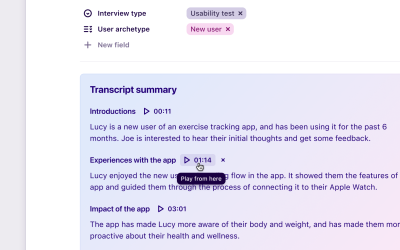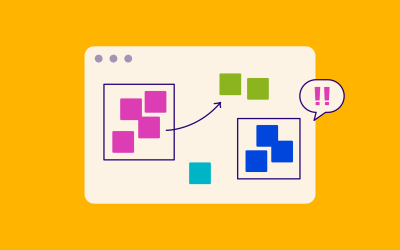Talking tagging taxonomies with Caitlin McCurrie
We’ve managed to pry Caitlin, a Lead Researcher at Atlassian, away from her current research projects to chat about her approach and considerations to tagging and taxonomies.
In the video below, we’ll be chatting to Caitlin about:
How she tags her data and at what level of granularity
Her approach to creating and maintaining a taxonomy
How she takes taxonomy inspiration from her time in academia
The time she created a top-down taxonomy in Dovetail
How she includes her stakeholders in the taxonomy process
What taxonomies to use for evaluative and generative research
Her approach to using fields in Dovetail
Looking for something to read? You’re in luck; check out some key quotes:
How do you define a tag?
With tagging, we’re trying to represent the things we want to measure—abstract concepts we can’t necessarily go and directly ask about. The thing we’re asking indirectly and trying to measure indirectly is called a latent variable. A tag is a way for me to represent how the data links to the latent variable that I’m interested in.
How do you tag your data?
I take the approach that all data is useful data.
How I tag something depends on the kind of data that I have in front of me, and what I’m interested in studying. If we’re tagging an interview, my tag would be the phrase, concept, or paragraph that captures the latent variable I’m interested in.
What’s your advice for people that are stressed about tagging?
Tags and taxonomies are just vehicles to help you understand the data. It doesn’t have to be perfect; you use it to understand the data better.
If that means you’re more comfortable using a top-down approach every time, even though it doesn’t look like the right thing on paper, do that. Don’t worry about getting caught up in using the exact correct language around your tag and what it’s called.
A summary of how Caitlin approaches creating a bottom-up taxonomy
Start with a fast pass through the data. I’ll go very quickly and tag any constructs that I’m interested in as they come up. I’m very free-form and generous about tagging here, almost trying to time myself with how fast I can go through my data. I don’t want to get caught up in the details because I’m trying to be big picture
Start recording observations. As I’m going through, I start to see patterns and see interesting things. I might get some post-it notes and start to record things that I’m observing as I’m capturing those tags
Stop at halfway. At about halfway, I have some sense of what’s going on with this topic that was pretty new to me before I started this research. Now that I see some interesting things arise, I like to stop at about the halfway mark, return to the tags, and start refining them
That’s when I’m starting to create that taxonomy.
Refine the tags. I consider whether I could have expressed that tag a little more succinctly, whether I’ve captured that latent variable that I was interested in there appropriately, whether I remove any quotes from that tag. I’m also starting to think about redundancy. I’ve been super free with my tagging up into this point, and I might have repeated myself, so I’ll start to combine my tags or delete some tags
Describe the tag. I’ll add a short description to my text. When you click into the tag feature in Dovetail, there’s an option to put some text below your tag. I’ll include some information on what that tag represents and how it relates to my construct
Continue. Now that I’ve got a slightly clearer picture of what constructs I see in my data, how they start to fit together, how I might talk about them, and what I should expect to see in the data when I am tagging, I go back and continue with the other half of my interviews. I’ll start to apply a more systematic process to the tagging of my data
Return to the first half. Depending on how much time I have in my project, I might even come back to the first half of my data and refine those tags as they apply to the first half. I’ll be more systematic, polish out the taxonomy that I’ve created, ensuring that the taxonomy now reflects my understanding of the subject
Continue recording observations. I’ll continue to take those post-it notes and memos about the patterns I see in the data. The taxonomy now is going to help me to understand the patterns and the relationships between those constructs
Review to insights. I’ll review my taxonomy and consider the relationship between different constructs. This might tell me something specific about what I’m interested in, the things that I’m studying in my research project. That’s when we start to move into the insights phase
From bottom-up to top-down. Now I’ve got a taxonomy that can then be used in a follow-up study, where we might have a bit more of a top-down approach to creating a taxonomy, a phase of research where I have existing data and existing insights. Maybe I’ve done something in an earlier project that’s directly related to this. I have a sense of the topic and what might be going on here. Say this is a secondary follow-up study to the one I was just describing, I already have that taxonomy. So I might adjust some tags and apply it to the second round of data collection.
Tagging taxonomies are one of the most discussed topics in Dovetail’s Slack community, you can continue the discussion there with over 2,300 other Dovetailers. If there’s a particular topic you’d love to hear more about, please let us know!
Written by Caitlin McCurrie, Ph.D., Lead Researcher, Atlassian and Liz Ross, Content Lead, Dovetail.
Get started for free
Log in or sign up
Get started for free
or
By clicking “Continue with Google / Email” you agree to our User Terms of Service and Privacy Policy


